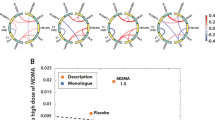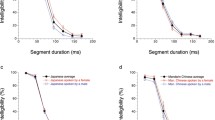Abstract
The present study investigates the effect of acute alcohol consumption on speech in Hungarian subjects. The measures used to reveal these effects were tongue-twisters, which were grouped according to their linguistic features. The number and type of speech errors while uttering the tongue-twisters were compared between intoxicated and sober conditions. The results showed that subjects made more speech errors in alcohol influenced than in sober states in all types of the tongue-twisters except for those using foreign words. Changes in the articulation rate, number of pauses and fundamental frequency were investigated as well. In the intoxicated state, no changes were observed in fundamental frequency and articulation rate, while the number of pauses increased.



Similar content being viewed by others
Notes
One unit is the equivalent of half a bottle (2.5 dl) of beer, 100 ml wine or a 40 ml shot of spirit.
References
Babor, T. F., Biddle-Higgins, J. C., Saunders, J. B., & Monteiro, M. G. (2001). AUDIT: The alcohol use disorders identification test: Guidelines for use in primary health care.
Behne, D. M., & Rivera, S. M. (1990). Effects of alcohol on speech: Acoustic analysis of spondees. Research on Speech Perception, 16, 263–291.
Behne, D. M., Rivera, S. M., & Pisoni, D. B. (1991). Effects of alcohol on speech: Durations of isolated words, sentences, and passages in fluent speech. Journal of the Acoustical Society of America, 90, 2311.
Boersma, P., & Weenink, D. (2009). Praat: Doing phonetics by computer (Version 5.1.05.). Computer Program.
Chin, S. B., & Pisoni, D. B. (1997). Alcohol and speech. San Diego: Academic Press.
Christenfeld, N., & Creager, B. (1996). Anxiety, alcohol, aphasia, and ums. Journal of Personality and Social Psychology, 70(3), 451–460.
Collins, P. J. (1980). A comparison of the oral syntactic performance of alcoholic and non-alcoholic adults. Language and Speech, 23, 281–288.
Cooney, O. M., McGuigan, K. G., Murphy, P. J. P., & Conroy, R. M. (1998). Acoustic analysis of the effects of alcohol on the human voice. Journal of the Acoustical Society of America, 103, 2895.
Crystal, T. H., & House, A. S. (1990). Articulation rate and the duration of syllables and stress groups in connected speech. Journal of the Acoustical Society of America, 88(1), 101–112.
Forney, R. B., & Hughes, F. W. (1961). Delayed auditory feedback and ethanol: Effect on verbal and arithmetical performance. Journal of Psychology, 52, 185–192.
Garrett, M. F. (1988). Processes in language production. In F. J. Newmeyer (Ed.), Linguistics: The Cambridge survey (Vol. 3, pp. 69–96). Cambridge: Cambridge University Press.
Givens, B. S., & Breese, G. R. (1990). Electrophysiological evidence that ethanol alters function of medial septal area without affecting lateral septal function. Journal of Pharmacology and Experimental Therapeutics, 253(1), 95–103.
Gósy, M. (2003). A spontán beszédben előforduló megakadásjelenségek gyakorisága és összefüggései. [Co-occurrence and frequency of disfluencies in Hungarian spontaneous speech]. Magyar Nyelvőr, 127, 257–277.
Gósy, M. (2004). Fonetika, a beszéd tudománya. Budapest: Osiris Kiadó.
Gyarmathy, D. (2008). Hogyan hat az alkohol a spontán beszédre?. In Á. Kuna & Á. Veszelszki (Eds.), Félúton 3 Konferenciakötet (pp. 81–99).
Haffner, H. T., Graw, M., Dettling, A., Schmitt, G., & Schuff, A. (2003). Concentration dependency of the BAC/BrAC (blood alcohol concentration/breath alcohol concentration) conversion factor during the linear elimination phase. International Journal of Legal Medicine, 117(5), 276–281. doi:10.1007/s00414-003-0384-5.
Hollien, H., DeJong, G., Martin, C. A., Schwartz, R., & Liljegren, K. (2001). Effects of ethanol intoxication on speech suprasegmentals. Journal of the Acoustical Society of America, 110(6), 3198–3206.
Hollien, H., Harnsberger, J. D., Martin, C. A., Hill, R., & Alderman, G. A. (2009). Perceiving the effects of ethanol intoxication on voice. Journal of Voice, 23(5), 552–559. doi:10.1016/j.jvoice.2007.11.005.
Hollien, H., Liljegren, K., Martin, C. A., & DeJong, G. (1999). Prediction of intoxication levels by speech analysis. In A. Braun (Ed.), Advances in Phonetics (pp. 40–50). Stuttgart: Steiner Verlag.
Hollien, H., & Martin, C. A. (1996). Conducting research on the effects of intoxication on speech. Forensic Linguistics: The International Journal of Speech, Language and the Law, 3, 107–127.
Hollingworth, H. L. (1923). The influence of alcohol. Journal of Abnormal Psychology and Social Psychology, 18, 204–237.
Hunt, W. A. (1985). Alcohol and biological membranes. New York: Guilford Press.
Johnson, K., Southwood, M. H., Schmidt, A. M., Mouli, C. M., Holmes, A. T., Armstrong, A. A., et al. (1993). A physiological study of the effects of alcohol on speech and voice. Paper presented at the 22nd annual symposium on the care of the professional voice at the voice foundation.
Jones, A. W. (2010). The relationship between blood alcohol concentration (BAC) and breath alcohol concentration (BrAC): A review of the evidence. Road Safety Web Publication, 15. Retrieved from http://www.dft.gov.uk/pgr/roadsafety/research/rsrr/theme3/report15.pdf website.
Klingholz, F., Penning, R., & Liebhardt, E. (1988). Recognition of low-level alcohol-intoxication from speech signal. Journal of the Acoustical Society of America, 84(3), 929–935.
Künzel, H. J., Braun, A., & Eysholdt, U. (1992). Einfluss von Alkohol auf Sprache und Stimme. Heidelberg: Kriminalistik Verlag.
Lester, L., & Skousen, R. (1974). The phonology of drunkenness. In A. Bruck, R. Fox, & M. W. LaGaly (Eds.), Papers from the parasession on natural phonology (pp. 233–239). Chicago: Linguistic Society.
Levelt, W. J. M. (1989). Speaking: From intention to articulation. Cambridge, MA: MIT Press.
Moskowitz, H., & Roth, S. (1971). Effect of alcohol on response latency in object naming. Quarterly Journal of Studies on Alcohol, 32(4), 969–975.
Pisoni, D. B., Hathaway, S. N., & Yuchtman, M. (1985). Effects of alcohol on the acoustic-phonetic properties of speech: Final report to GM Research Laboratories. (SRL Technical Note No. 85–03). Bloomington: Indiana University.
Pisoni, D. B., & Martin, C. S. (1989). Effects of alcohol on the acoustic-phonetic properties of speech—perceptual and acoustic analyses. Alcoholism-Clinical and Experimental Research, 13(4), 577–587.
Schiel, F., & Heinrich, C. (2009). Laying the foundation for in-car alcohol detection by speech. Paper presented at the INTERSPEECH, Brighton, UK.
Smith, R. C., Parker, E. S., & Noble, E. P. (1975). Alcohol’s effect on some formal aspects of verbal social communication. Archives of General Psychiatry, 32, 1394–1398.
Sobell, L. C., & Sobell, M. B. (1972). Effects of alcohol on the speech of alcoholics. Journal of Speech and Hearing Research, 15(4), 861–868.
Sobell, L. C., Sobell, M. B., & Coleman, R. F. (1982). Alcohol-induced disfluency in nonalcoholics. Folia Phoniatrica, 34, 316–323.
Starmer, G. A. (1989). Effects of low to moderate doses of ethanol on human driving-related performance. In K. C. Crow & R. D. Batt (Eds.), Human metabolism of alcohol (Vol. 1, pp. 101–130). Boca Raton, FL: CRC Press.
Suzdak, P. D., & Paul, S. M. (1987). Ethanol stimulates GABA receptor-mediated Cl- ion flux in vitro: Possible relationship to the anxiolytic and intoxicating actions of alcohol. Psychopharmacology Bulletin, 23(3), 445–451.
Szabó, E., Rossu, R., Varga, V., & Imréczi, K. (2012). Az alkohol hatása a rövid távú emlékezetre és a beszédprodukciós folyamatokra. Magyar Pszichológiai Szemle, 67(3), 409–430.
Trojan, F., & Kryspin-Exner, K. (1968). The decay of articulation under the influence of alcohol and paraldehyde. Folia Phoniatrica (Basel), 20(4), 217–238.
Wallgren, H., & Barry, H. (1970). Actions of alcohol. Amsterdam: Elsevier.
Watanabe, H., Shin, T., Matsuo, H., Okuno, F., Tsuji, T., Matsuoka, M., et al. (1994). Studies on vocal fold injection and changes in pitch associated with alcohol intake. Journal of Voice, 8(4), 340–346.
Widmark, E. M. P. (1981). Principles and applications of medicolegal alcohol determination. Davis, CA: Biomedical Publications.
Zaimov, K. (1969). Die Sprachstörungen als Kriterium der Bewusstseinsstörungen. Psychiatrie, Neurologie, und Medizinische Psychologie, 21, 218–225.
Acknowledgments
We thank Dora Somogyi for the language correction and Katinka Imréczi for her assistance.
Author information
Authors and Affiliations
Corresponding author
Appendix
Appendix
List of the Tongue-Twisters
-
A.
Phonetic tongue-twisters
-
a.
ha a hörcsög szörpöt szörcsög, rátörnek a hörcsög görcsök
-
b.
pepita bóbitás babapókok pattognak a bobpályán
-
c.
Tóth Tódor doktora Tóth Dorka doktora is
-
d.
rálel-e e remek lelet lereagálására
-
e.
szétzúzott cicaszántás
-
f.
sóska zsúri csacska zsűri
-
g.
pocakon pöckölt icike-picike pocok
-
h.
Lenin mauzóleumának lelinóleumozása
-
i.
zabra zebra zsebre zabra
-
j.
fekete bikapata kopog a patika pepita kövén
-
a.
-
B.
Phonologic tongue-twisters (minimal pairs)
-
a.
már mér kér két lét
-
b.
hány lány lát fát
-
c.
pót sót sóz Óz, ez íz így egy kegy
-
d.
két kék fék fér
-
e.
száz szász szesz lesz
-
a.
-
C.
Morphologic tongue-twisters (conjugation)
-
a.
lassan látni
-
b.
két kérdést kérdezni
-
c.
felfogni, hogy felfogtátok
-
d.
várni a váram
-
a.
-
D.
Syntactic tongue-twisters
-
a.
Nem lehet a Márta másé, mert a Márta már Tamásé.
-
b.
Szemben a nagy teátrummal, iszik egy úr teát rummal, de mire a tea kész lett eltörött a teás készlet.
-
c.
Nem minden fajta szarka farka tarka-barka, csak a tarka fajta szarka farka tarka-barka.
-
d.
Az igazság a gazság igazsága?
-
e.
“Aj, e nő-kebelű Lidi óta, a Jenőke belül idióta.”
-
f.
Már itt volt ősz szinte, mikor egy őszinte ősz inte, hogy legyek őszinte, mert ő szinte őszinte.
-
a.
-
E.
Foreign words
-
a.
kalazantinum
-
b.
mezateriitisz
-
c.
patriszticizmus
-
d.
emplaiztrum
-
e.
kromatipográfia
-
f.
szekvesztráció
-
g.
nomonogáfia
-
h.
nummulitok
-
i.
xeroftalmia
-
j.
vucsicsevázok
-
a.
Rights and permissions
About this article
Cite this article
Tisljár-Szabó, E., Rossu, R., Varga, V. et al. The Effect of Alcohol on Speech Production. J Psycholinguist Res 43, 737–748 (2014). https://doi.org/10.1007/s10936-013-9278-y
Published:
Issue Date:
DOI: https://doi.org/10.1007/s10936-013-9278-y




